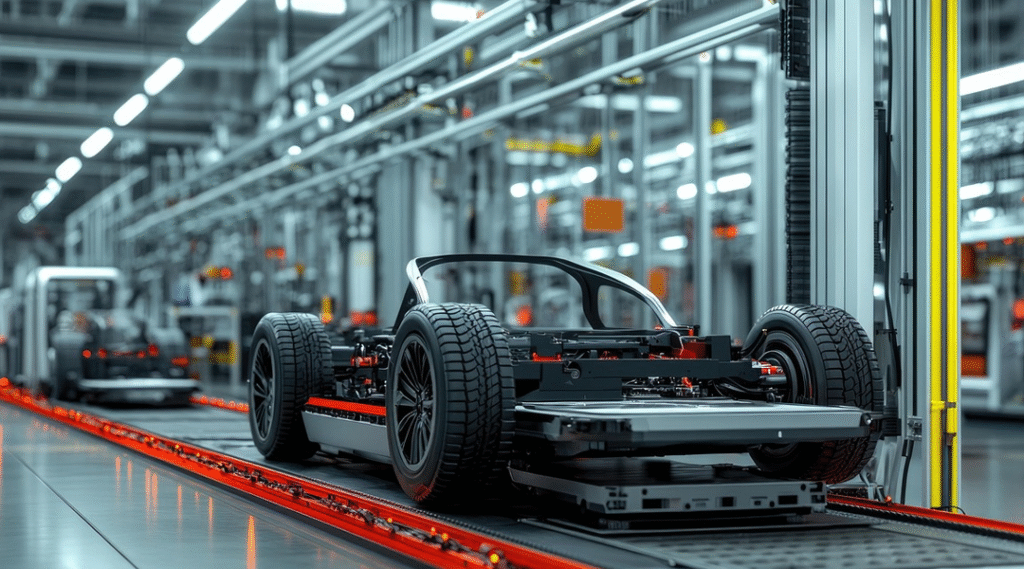The automotive landscape is evolving at breakneck speed. In 2025, vehicles are no longer just mechanical conveyances—they’re electric powerhouses, software-defined platforms, and connected mobility hubs. From revolutionary batteries to autonomous software, here are the six game-changing technologies steering us into the future.
1. Next-Gen Electric Powertrains
Solid-State Batteries
- Boasting up to twice the energy density of today’s lithium-ion packs, solid-state cells promise 400–600-mile ranges on a single charge and charging times under 15 minutes.
- Early production models are slated for late 2026, with partnerships between Toyota, QuantumScape, and BMW leading the charge.
Ultra-Fast Charging Networks
- Networks capable of delivering 350 kW+ are rolling out across major highways, enabling drivers to add 200 miles in roughly 7–10 minutes.
- Companies like Ionity (Europe) and Electrify America (U.S.) plan to triple station counts by 2027, reducing range anxiety for long-distance travel.
2. Ubiquitous Connectivity & V2X
5G-Powered Vehicle-to-Everything (V2X)
- With millisecond-level latency, 5G links connect cars to traffic signals, pedestrians’ smartphones, and other vehicles, dramatically improving collision avoidance and traffic flow.
- Pilot projects in Germany and Singapore have demonstrated up to 30% reductions in intersection accidents.
Cloud-Native Cockpits
- Automakers are adopting centralized “vehicle clouds” to store driver preferences, navigation histories, and software modules.
- Over-the-air (OTA) updates now cover everything from infotainment tweaks to full self-driving beta releases, keeping cars perpetually up to date.
3. Software-Defined Vehicles & Smart Architectures
Centralized Compute Platforms
- Future vehicles consolidate hundreds of electronic control units (ECUs) into a handful of high-performance nodes, streamlining wiring and boosting processing power.
- Zonal architectures—dividing the car into logical zones managed by dedicated controllers—are becoming the new industry norm.
Rapid Feature Deployment
- Subscription-based functions (e.g., heated seats, advanced driver assists) can now be activated remotely, allowing owners to pay for—and manufacturers to monetize—features on demand.
4. Advanced Autonomy Taking Shape
Level 3/4 Automation Pilots
- Several manufacturers are testing hands-off highway driving in limited regions, with Toyota and Audi launching Level 3 services in select U.S. states this year.
- Robotaxi fleets, spearheaded by Waymo and Cruise, are expanding beyond downtown corridors into suburban neighborhoods, offering point-to-point rides in geofenced areas.
Vision-First Self-Driving
- Companies like Honda-backed Helm.ai are proving that camera-based systems can rival lidar-equipped rivals, using AI to interpret complex scenes at a fraction of the hardware cost.
5. Fortifying Automotive Cybersecurity
Holistic Security Frameworks
- New regulations (e.g., EU’s Cybersecurity Act for vehicles) mandate end-to-end encryption, secure boot mechanisms, and intrusion detection systems embedded in the vehicle network.
- Automakers now conduct “red-team” penetration tests and participate in industry bug bounties to uncover vulnerabilities before malicious actors do.
Data Privacy & Ownership
- GDPR-style laws are being adopted worldwide, granting drivers more control over how telemetry and usage data is collected, shared, and monetized.
6. Sustainable Materials & Circular Manufacturing
Eco-Friendly Interiors
- Leading brands are swapping traditional leathers for bio-based fabrics, recycled plastics, and upcycled ocean plastics, reducing the carbon footprint of each cabin.
Carbon-Neutral Factories
- Digital twins and AI-driven process optimizations are helping plants run on 100% renewable energy by 2030.
- Closed-loop recycling systems recover metals and composites from end-of-life vehicles, feeding them back into new production lines.
Why These Advances Matter
- Efficiency & Range: Breakthrough batteries and charging solve the two biggest barriers to EV adoption.
- Safety & Intelligence: Real-time connectivity and autonomous capabilities promise fewer accidents and more seamless commutes.
- Longevity & Flexibility: Software-defined architectures and OTA updates extend vehicle lifespans and customize functionality.
- Responsibility & Resilience: Strong cybersecurity and sustainable practices ensure that tomorrow’s cars are safer for people and the planet.
As these technologies mature, our relationship with the automobile will shift from ownership of hardware to subscription-driven mobility experiences. By the end of the decade, it won’t be unusual for cars to arrive by drone delivery, drive themselves to charge, and adapt their capabilities to your day—all while leaving a near-zero environmental footprint. The road ahead has never been more exciting.
More for the relative topic:
Future Outlook & Strategic Imperatives for the Automotive Aftermarket
As for in-depth insight articles about AI tech, please visit our AI Tech Category here.
As for in-depth insight articles about Auto Tech, please visit our Auto Tech Category here.
As for in-depth insight articles about Smart IoT, please visit our Smart IoT Category here.
As for in-depth insight articles about Energy, please visit our Energy Category here.
If you want to save time for high-quality reading, please visit our Editors’ Pick here.



